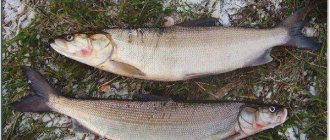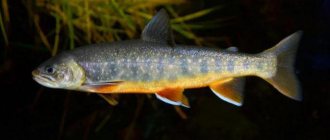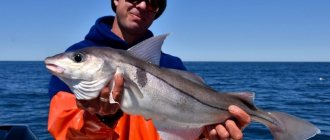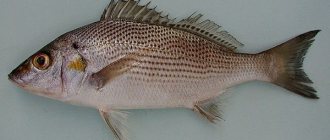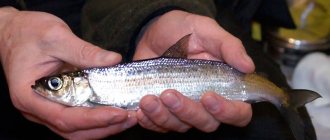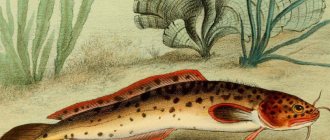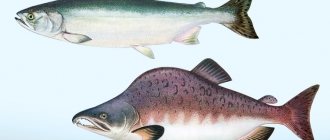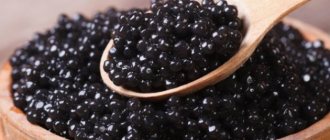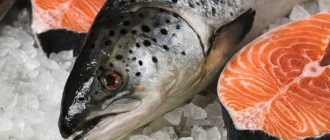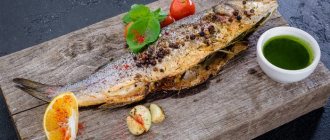Description of silver carp
Silver carp is also called silver carp and bighead. The fish is large in size; with a length of 1.5 meters, the weight of the fish can reach more than 27 kilograms. Officially registered weight is 50 kilograms. Fishermen are diligently trying to catch trophy fish, because they are valued not only for their impressive dimensions, but also for their nutritional value, beneficial properties and unique taste.
The fish has silvery sides. The belly color varies from silvery white to pure white. The eyes are located far on the head and point slightly downward. The silver carp differs from other fish by having a wide forehead and mouth.
On the large head of the silver carp there is a mouth without teeth. Visually, the mouth appears upside down. The fish's mouth is a filtering apparatus that looks like fused gills, similar to a sponge. This structure contributes to better capture of the main food source - plankton.
When introducing silver carp into artificial ponds for fish breeding, its effective preservation from water pollution and algal blooms is guaranteed. The silver carp has a long body covered with small scales.
Types of bighead
There are only three varieties of silver carp, which are characterized by different colors and significant differences in weight. The following types of silver carp are distinguished:
Bighead carp
Bighead carp have a large head, large fins and a long tail. Adult individuals are characterized by a color more close to black. There are spots on the sides. Young specimens have golden skin and scales. The fish's gills do not grow together with stamens, due to which the fish can easily feed on zooplankton. Unlike silver carp, the keel on the belly starts from the ventral fins and extends to the anal feather.
The fish grows up to 1.5 meters in length, and its maximum weight is 40-60 kilograms. The preferred food for fish is phytoplankton. Spawning occurs in late spring and early summer, when the water temperature reaches 18-30 degrees. The fish reaches sexual maturity at 2-6 years, depending on the habitat. Maximum fertility is observed in the waters of Turkmenistan and Moldova: one female can spawn from 600 thousand to 1 million eggs.
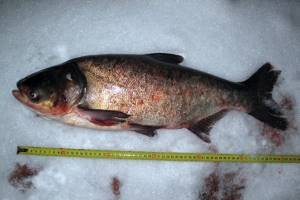
It is distinguished by its high economic importance:
- Reclamation of reservoirs;
- grows quickly, gains weight just as quickly;
- Bighead carp meat is of high quality and in demand.
Silver carp
The fish has a tall body with a silver color. A distinctive feature is a large head with low-set eyes and dark fins. The maximum weight of the fish varies within 20 kilograms with a length of up to 1 meter. It is characterized by the presence of a ventral keel, which begins in the neck of the fish, reaching the anal fin.
For feeding white fish, the optimal temperature is 25 degrees. For this reason, flocks constantly move around the reservoir during the day, in search of comfortable living conditions: in the morning they live near the shore, in the afternoon they choose deeper places in the bays, settling in the middle layers of reservoirs.
When cold weather sets in, closer to mid-autumn, silver carp practically do not feed. The exceptions are those individuals that live in warm-water canals and reservoirs.
The unique structure of the gill apparatus allows the fish to feed on phytoplankton, filtering it from the water. Meat is characterized by high gastronomic value. Its fat content ranges from 4 to 23%, which increases with the age of the individual and weight gain.

Fish oil has a consistency and properties similar to the fat of marine life. When used as food, the level of cholesterol in the blood decreases. Recommended when following a diet. A delicious balyk is prepared from the meat of silver carp.
Hybrid
The hybrid silver carp was bred by fertilizing the eggs of a white individual with the milk of a motley silver carp. The main derivative of this breeding is that the species includes all the best qualities of the parents:
- instantly gains weight, increases in size as quickly as possible;
- prone to tolerate low water temperatures;
- has a small head in contrast to the white species;
- feeds on phytoplankton;
- The scales and skin of this species are white.
Such features contribute to the fact that this type of fish can be settled in colder regions and water areas where this was previously impossible.
The benefits and harms of silver carp
Fish is a healthy dietary product. Regular consumption of seafood helps improve the general condition of the body, increase bone strength, lose weight and normalize the functioning of the cardiovascular system. One of the best dinner options is silver carp, which is rightfully considered a storehouse of nutrients.
Useful and healing properties
Thanks to a large number of useful microminerals and substances, silver carp is able to have the following effects on the body:
- normalization of the nervous system;
- lowering blood cholesterol levels;
- increased skin tone thanks to Omega-3;
- normalization of pressure;
- improving the functioning of the vascular system and heart;
- preventing the formation of blood clots;
- increase hemoglobin synthesis;
- has a beneficial effect on the condition of the skin;
- improves the functioning of the reproductive system;
- prevents the formation of wrinkles.
It is undesirable to consume only smoked fish prepared by hot smoking, as it contains many carcinogens.
Where are silver carp found?
Initially, silver carp was found only in the territory of modern China . As a result of constant floods, fish were able to emigrate to Russian rivers. Now it can be caught in the Volga, Kuban, Terek and other deep rivers.
Energy value per 100 g
| Kcal | Fats | Squirrels | Carbohydrates | |
| Young silver carp | 87 | 0.8 g | 20 g | 0.3 g |
| Old silver carp | 90 | 1 g | 20 g | 0.3 g |
| Boiled fish | 77-80 | 0.6 g | 20 g | 0.3 g |
| Fried fish | 175-200 | 7.98 g | 19 g | 2.63 g |
| Stewed fish | 77-80 | 0.6 g | 20 g | 0.3 g |
Mineral composition
| A | 0,03 |
| B1 | 0,07 |
| B2 | 0,2 |
| B3 | 3 |
| Phosphorus | 250 mg |
| Sulfur | 180 mg |
| Magnesium | 45 mg |
| Fluorine | 0.6 mg |
| Iodine | 0.8 mg |
Application for weight loss
Thanks to its large amount of protein, silver carp is a popular dietary product . There are several types of diets with this fish:
- mono-diet , which involves eating silver carp in any form for 7-10 days;
- 6 petals diet, on the first day of which it is recommended to eat only boiled fish;
- weight loss system -60 , which recommends eating one serving of fish for dinner.
Use in healthy eating
To keep the body in good shape, it is enough to consume 2-3 servings of fish per week .
- People suffering from heart disease and nervous disorders are recommended to eat boiled or stewed silver carp 3-4 days a month.
- For children from 1 to 5 years old, one serving of silver carp per week is enough; if the child is not allergic, the fish can be consumed 2 times.
- After 5 years, fish consumption is allowed up to 3 servings weekly.
- If you want to lose weight, you can eat silver carp every day for dinner for a week, and then go back to your normal healthy diet.
There are several rules when buying silver carp:
- buy an individual weighing at least 2 kg;
- purchase fish only in places where storage standards are not violated;
- there should be no dark spots on the silver carp;
- the tail of the fish should not bend and be soft;
- the smell should resemble algae without any impurities;
- after pressing the fish there should be no dents left;
- the eyeballs should remain clear;
- there should be no spots on the gills and the color should be pink.
Features of silver carp storage
It is advisable to consume fish immediately after purchase without freezing , as it loses many beneficial properties during storage. If this is not possible, it should be put in a plastic bag and frozen, then consumed within 3 months. In this case, the carcass should be divided into several pieces and each of them should be packaged separately.
Thawed silver carp should be eaten within 24 hours . Dried and smoked fish can be stored unpacked for up to 7 days , dried fish can be consumed within 30 days .
Contraindications and harm
There are no serious contraindications to consuming silver carp. These only include the following:
- seafood allergy;
- age up to 1 year;
- gastrointestinal diseases.
The last point applies only to dishes prepared by frying, deep-frying and smoking.
Silver carp is an excellent option for a healthy and maximally healthy dinner. This product is suitable for nutrition at any age, thanks to its amazing composition. Silver carp can only be replaced with fish varieties of similar composition, which include trout, salmon and cod. But due to the high price of these types of fish, silver carp becomes simply an ideal option for a family.
If you do not suffer from allergies and are attentive to your health, be sure to try this incredibly tasty and tender fish. If you have already cooked silver carp and have your own opinion about it, be sure to share it in the comments .
Source: https://www.davajpohudeem.com/pitanie_dlia_pohudeniya/svoistva_produktov/ryba-moreprodukty/tolstolobik-polza-i-vred.html
Habitat and living conditions
Silver carp were first developed in the 1970s in the United States, where they were recorded in several locations throughout the Central and Southern regions. Silver carp prefer to live in the Mississippi River basin, where they form spawning grounds. The fish was introduced throughout the world, which is why fishermen often hunt it in East Asia, Africa, Mexico, and the Antilles.
Silver carp lives in almost all water bodies of Russia, but, as a rule, exclusively in those places where it was introduced artificially. Usually the fish start in the spring, forming schools; they completely settle into the territory of the reservoir. During the period of warming water and the growth of various vegetation, fish activity decreases, silver carp settles in one place.
As a rule, silver carp prefers to be in places with a muddy bottom and soft aquatic vegetation, where the depth is no more than 3 meters. Before sunset and early morning, the fish move closer to the shore. During the day, silver carp tries to stay away from the shore.
Where does it live?
Silver carp feels great in low-flowing water, which is heated to a temperature of +24-25°C. It is unpretentious to the amount of oxygen and adapts well even in stagnant ponds and lakes. The species is native to Eastern and Southeast Asia, as well as the Amur basin (Vietnam, Malaysia, China, and the Russian Far East).
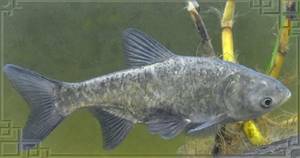
Now Hypophthalmichthys molitrix has been successfully colonized in water bodies of the Urals, the North Caucasus, and the Central European part of the Russian Federation with a temperate continental climate. But silver carp has taken root especially well in the warmer lower reaches of the Kuban, Volga, Don, and Dnieper. Silver carp are successfully grown in small, medium and large reservoirs throughout the country.
The favorite habitats of silver carp are areas with a muddy or soft bottom, overgrown with bottom, tall or floating vegetation. It avoids great depths with cool water, so it sticks to relative shallows (2.5-3.5 m), which warm up well during the day and do not have time to cool down at night. In the hot summer months, fish move from the shore to open reaches, where they feed in the middle and lower layers, regularly moving from the bottom to the surface and back.
To learn more:
Amur catfish - description and characteristics of fish
Behavior and lifestyle
Bigheads are fish that occupy the middle and upper layers of the depths. The fish is found in the waters of large rivers, creeks, lakes, warm-water ponds, and flooding areas that are connected to large rivers. They tend to live in still water and where there is current. The ideal habitat for silver carp is calm, warm waters with a gentle current. Fish do not linger in waters with strong currents - this scares them away. Favorite places are shallows with a light current, a muddy, sandy or rocky bottom, as well as artificial reservoirs where there is a lot of nutritious plankton.
When going fishing, it is better to look for silver carp in quiet backwaters that are located away from major roads and city noise. Silver carp can tolerate a wide range of temperatures - from 0 to 40 degrees, low oxygen levels, slightly salty water.
At different times of the year, the behavior of fish changes:
- In autumn, when the water temperature is below 8 degrees, silver carp actively accumulates fat.
- In winter, the fish goes into deep sleep, choosing holes at the bottom of the reservoir.
- In spring, a lot of detritus and plankton appear in the water, due to which, after waking up, the fish goes in search of food. First, it examines the depths and only when the water temperature reaches 24 degrees does it rise to the surface. During this period, due to severe hunger, silver carp grabs any bait, which makes it easy to catch. At the end of May, fish can be caught even with a piece of cigarette filter or foam rubber.
Under favorable conditions, the fish can live up to 20 years. In conditions of industrial breeding, this is not at all profitable, which is why the fish are caught for sale when they reach 2-3 years, when the size is appropriate.
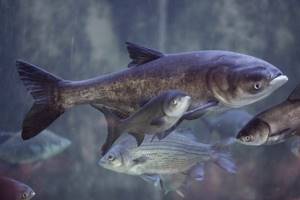
The nutritional value
100 g of silver carp contains more than 19 g of protein, about 0.9 g of fat and almost 79 g of water. It also contains (per 100 g of fish):
- Vitamins:
- A-33.7 mcg,
- B1−0.04 mg,
- B2−0.112 mg,
- PP-2.9 mg,
- E-0.112 mg.

- Macroelements,
- Microelements,
- Polyunsaturated fatty acids:
- Omega-3−0.149 g,
- Omega-6−0.008 g.
Diet
The diet of bighead fish depends on the type and age of the fish. These are mainly animal and plant plankton. Silver carp prefers to eat plant foods - its menu consists of phytoplankton. The most delicious dish for it is considered to be blue-green algae, which appears in all fresh waters when the heat sets in. Due to this, silver carp is a welcome guest in reservoirs with stagnant water, because eating algae helps fight the main source of diseases in the reservoir.
Bighead carp likes the same diet as white fish. But together with phytoplankton, it prefers to eat small foods of animal origin. Such rich nutrition ensures rapid growth, which leads to the achievement of large sizes.
Russian breeders managed to develop a silver carp hybrid by crossing a white and a motley variety of fish. This resulted in one species receiving all the benefits. The hybrid fish has a small head, like the bighead carp, but boasts a large size. Because of this, its menu is much wider. In addition to animal and plant plankton, the hybrid individual feeds on small crustaceans. At the same time, the digestive system is adapted to special feed mixtures for artificial breeding.
Spawning
Puberty of silver carp occurs when the fish reaches the age of 5 years. Determination of a fish that has reached maturity is simple: the scales become grayish-blue in color. The spawning process begins in a reservoir when the water warms up to a temperature of 20 degrees. As a rule, this is the end of May or the beginning of June.
With a fish weighing more than 20 kilograms, it is capable of laying up to 3 million eggs. Females living in artificial ponds do not favor such indicators - the number of eggs is no more than 1 million.
The newly born young feed on zooplankton, due to the fact that the gill filtering apparatus is not developed. This type of nutrition promotes rapid weight gain. Fish will be able to feed on algae only after their gills have formed - when they reach a body length of 5 centimeters.
How to choose
To enjoy the taste, you need to be able to choose the right carcass. The best option is an individual weighing 2-3.5 kg. At this age, she has a lot of meat and few bones.
When making a choice, you should also pay attention to the following facts:
- eyes are not cloudy;
- elastic tail;
- scales – silvery, with a special shine;
- the gills are always pink;
- presence of pond odor;
- When pressed with a finger, the dent is quickly restored.
Attention. When purchasing, it is advisable to read the sanitary certificate for the sale of the product.
Natural enemies
Silver carp fry are threatened by predatory pike, and very rarely by large perch. After a silver carp is released into a pond, the toothy predator categorically refuses artificial bait. Due to the attacks of enemies, schools of small silver carp become much rarer. This threat to the population remains until the fish is 2 years old, when it gains sufficient weight and increases in size.
Also dangerous is the fact that bigheads can harm the ichthyofauna of water bodies. Due to the consumption of all types of plankton in large quantities, the fry of other fish are left without a food source, which does not allow them to fully develop.
Diseases
Silver carp are carriers of the Asian tapeworm, a parasite that has a negative effect on the development and growth of fish. Through the consumption of raw fish meat or a poorly thermally processed product, the possibility of human injury cannot be excluded. The parasite develops in the human intestine, affecting the intestinal mucosa.
Symptoms of infection include vomiting, diarrhea, and severe pain in the lower abdomen. If you notice signs after consuming silver carp products, you must go to the hospital and have your blood tested.
You can avoid infection if you fish in trusted places, buy the product from reputable sellers, and subject silver carp to long-term heat treatment during cooking. When salting, keep the fish in salt for at least 5 days, followed by soaking.
Beneficial features
The energy value of 100 grams of silver carp is 86 calories. Depending on the cooking method, age and size of the fish, the indicator changes. For example, when stewing, the calorie content of fish is 76 energy units, when frying it is 71 calories.
Fish meat that is 5 years old is considered fattier and therefore has a higher energy value. At the same time, the meat contains useful, easily digestible proteins and carbohydrates, omega-3, omega-6 acids, vitamins D, E and group B, provitamin A. Silver carp meat is rich in phosphorus, sulfur, iron, zinc, sodium, and calcium.
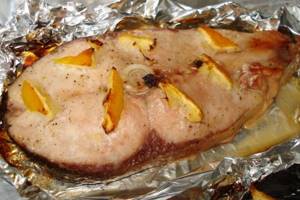
Omega-3 and omega-6 acids, when consumed regularly, improve human health:
- reduce cholesterol levels;
- prevent the formation of malignant tumors;
- relieve nervous disorders, depression, stress;
- reduce the risk of developing cardiovascular failure and hypertension.
Due to the huge amount of minerals in fish, the growth of nails and hair improves; stimulates the production of iron-containing hemoglobin, which performs the function of gas exchange; toxic substances are removed from the body; reparative regeneration occurs, including the skin.
People who suffer from diabetes, hypertension, gout, gastritis, and low acidity are required to consume silver carp meat, preferably boiled, stewed or steamed. After just a few weeks, a decrease in cholesterol levels and normalization of blood pressure are observed.
Compound
It contains many fatty acids that are necessary for the normal functioning of the human body.
Its meat contains such important acids as:
- Alpha-linolenic acid (this substance plays an important role in supporting and normalizing the immune system).
- Polyunsaturated eicosapentaenoic acid (the main component of fish oil. Necessary for the proper functioning of the cardiovascular system).
- Docosahexaenoic acid (found in the tissues of living organisms as part of lipids).
Breeding and rearing
Growing silver carp is a difficult process that requires the creation of special conditions. The water in the pond should be no more than 25 degrees. Fish are thermophilic, preferring the sun, muddy bottom and reservoirs where there is a lot of vegetation. The ideal depth for fish is 3-4 meters. At dawn and dusk, silver carp swim into shallow water and hide at the bottom during the day.
What do you feed fish when breeding?
The diet of silver carp consists of phytoplankton, zooplankton, which is a source of proteins. There are three varieties of silver carp, which have not only ecological, but also morphological differences. They are also not similar in their dietary preferences. Silver carp are medium-sized schooling fish that consume only phytoplankton. Bighead carp are large fish that feed on zooplankton, which contributes to rapid growth and weight gain. Hybrids are large fish that consume everything that bighead and silver carp eat.
Silver carp can also eat artificial food. They reach marketable weight already at the age of 2 years, because their weight reaches about 500-600 grams. Sexual maturity in fish occurs at the age of 3-5 years, when the body length is 50 centimeters.
Silver carp breeding is possible in a pond. Be sure to take into account the requirements for maintenance conditions, size and depth of the pond. It is advisable to separate individuals by size, thereby avoiding the spread of diseases and improving breeding and rearing conditions.
Construction of a pond
It is optimal to choose or prepare your own pond, the size of which will be 200-300 square meters. It is filled with various plants for better attachment of eggs during the spawning process. Spawning grounds are used at the end of May or beginning of June for no more than 14 days.
The first time the fish are transplanted is after 5-7 weeks after birth. There are up to 900 individuals per 1 hectare of reservoir, if their growth is no more than 2 kilograms. At first, the stocked fish feed on natural food, which must be regularly added in large quantities to the bottom of the pond. In the fall, future producers are selected, placing them in a separate reservoir, where they will remain until spawning.
As a business, growing silver carp is considered a simple but labor-intensive task that requires compliance with the basic rules:
- Fish will not be able to get enough nutrients from feed if the water temperature is less than 18 degrees. All the energy that it will receive is spent on maintaining life, and there are no reserves left. This results in the fish not gaining enough weight.
- Reservoirs must be regularly cleaned and disinfected, otherwise the fish will develop infectious diseases.
- Agricultural products are subject to a certain agricultural tax. Due to this, the sales volume should represent 70% of agricultural products. The main income is considered to be profit received from processing or retail sales.
First of all, they thoroughly study the area of the site for fish breeding, the depth of the pond, the possibility of supplying and discharging water. It will be possible to achieve profitability when growing white or hybrid silver carp, because they grow quickly, and 80% of their body weight is suitable for consumption. This helps to achieve an increase in the reservoir of up to 600 kilograms.
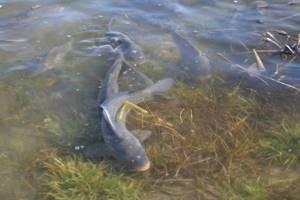
Costs and payback
When calculating the cost of fish and feed, it is possible to calculate future profits. 5 tons of fish are placed on 10 hectares of reservoir. The average price of 1 kilogram of silver carp is 100 rubles. So, the income from the sale of this quantity will be about half a million rubles. Costs include the purchase of food, fishing, pond protection, transportation and advertising. Only by deducting all expenses will it be possible to calculate net profit. On average, 3 kilograms of feed yields an increase of 1 kilogram of fish. Often costs can be higher than profits if you don’t start growing food on an area near a pond.
If the area does not allow this, it is recommended to breed geese, but the pond must process pollution from living creatures. Geese fertilize the pond, clean it, thereby creating additional food for the fish, exterminating fish parasites and carriers of their diseases. Geese also lay eggs, which they later sell, which provides a special benefit.
It would not be superfluous to organize amateur fishing in a pond as an additional income for charging a certain fee. This will not only popularize the enterprise, but will also increase earnings. Silver carp are deep-sea and heavy fish: they do not bite on a fishing rod and are quite difficult to catch. This ensures additional profit in relation to the complete absence of costs.
Silver carp fishing
Catching silver carp brings incredible pleasure, and the main trophy for a fisherman is the capture of a large specimen. To make the process easier, use float or bottom tackle, technoplankton. The “right” bait will help you catch good fish.
For float tackle
It is believed that a simple way to catch silver carp is a universal carp tackle for long-distance casting. In this case, it is important to choose the right float - it must be transparent. Regular floats can scare away the fish. Greater depth is required, although fish can be no deeper than 15 centimeters from the surface.
If the selected body of water contains all kinds of sticks or reeds, use balsa floats. But the float with the antenna is not placed in a vertical position - this can alert the silver carp if the float stands out among the branches located horizontally. It is better to secure it in the same way as the branches lie.
For fishing, it is recommended to use several float options:
- An oblong foam float surrounded at the bottom with several pellets. The upper part of the equipment has a bright color tint, the bottom is protective. Due to the fact that the fish looks at the food from below from the reservoir, and all objects seem blue to it, it is advisable to choose floats with a bluish, gray or white tint on the bottom.
- Universal with antenna. It would be better if these were floats that required passing the fishing line through the cambric on the antenna. They surrounded it so that the antennas did not stand, but were on the surface of the water.
On technoplankton
Over the past few years, many fishermen have managed to master silver carp fishing using special compressed bait - technoplankton. In the water, it gradually disintegrates, which is why a cloud of turbidity is created around it, similar to the natural food preferred by silver carp - phytoplankton. Externally, the bait is a barrel with a hole along its entire length - it is mounted on a thin rod. Specialized stores may offer a more economical option - crumbly technoplankton, but you will have to press it yourself.
The use of technoplankton involves long-distance casting and vertical fishing. The bait is installed on a special equipment called a silver carp stick. The float holds it in a given horizon after casting. Depth varies from 30 centimeters to 1 meter. This is the best fishing area.
Technoplankton has neutral buoyancy. When the turbidity attractive to fish disintegrates and spreads, near which the hooks are placed, one of the fish will sooner or later be sucked in.

The silver carp stick is a floating piece of equipment that needs to be fixed in one place, otherwise the consumption of technoplankton will be useless.
Some fishermen use a sliding sinker above the float, but this arrangement negatively affects casting distance. Others combine a sliding float, limited by a stopper, and a blind weight, placing it at the end of the main line. After casting, the sinker ends up on the bottom, and the bite alarm rests against the stopper, due to which the equipment rises. The use of this option requires accurate knowledge of the depth at the fishing point in order to correctly set the stopper.
Instead of sticks and technoplankton, a spring feeder filled with catchable mixtures is often used in the equipment. At the same time, it is taken into account that the mass of the equipment will significantly increase in volume, because homemade bait is much heavier than technoplankton. You may have to take a fishing rod with a higher test weight and use a float with a higher carrying capacity.
For bottom tackle
The design of equipment for donkey is quite simple. On a large spring feeder, install 2-3 hooks on leashes at least 20 centimeters long. It is recommended to make leashes from braided cord with a diameter of up to 0.12 mm. Foam balls are attached to the hooks - the fish sucks them in along with the rising particles of food and is hooked itself.
Donka fishing has several significant disadvantages. First of all, you need to make your own bait. An error in proportions results in the bait not being “dusty.” In such a situation, experienced fishermen get out of the situation by adding an Alka-Seltzer tablet to each filled feeder - when the drug reacts with water, it begins to boil and destroy the mixture from the inside.
Another negative point is the fishing horizon. Large specimens rarely sink to the bottom; they prefer food that accumulates in the upper layers. But despite this, bottom tackle is simple and affordable, which is why it is so popular.
Bait
Many people do not believe that silver carp is a fish that can bite on a completely bare hook without bait. But it's actually real. There is no need to use anything, not even any vegetables on the hooks. It's not a matter of whether there is bait, but what kind of hook they use and what is around it. That is, if an empty hook falls into an area where plankton is present, the silver carp can swallow it in turbid water without noticing.
Greater success is guaranteed with a larger number of hooks, because during active feeding, the fish will definitely stumble upon one of them.
If you are not sure that this method will give results, it is permissible to use porridge for fishing. But in this case, you cannot do without special ingredients. As a rule, in such cases, purchased “Geysers” are used, which have proven themselves to be excellent when catching silver carp. Sometimes bait is replaced with Yubileinoe cookies, mixing it with porridge, cake, halva, bread, etc.
Please note: fishing during spawning is prohibited by law!
Silver carp is a unique fish that simply amazes with its large size, due to which it attracts not only fishermen who want to get such a trophy, but also entrepreneurs who decide to get a business from selling marketable fish. Breeding and growing fish in your summer cottage is possible if you comply with all the necessary requirements.
0
0
Copy link
How to catch
Despite the fact that fishing enthusiasts are well aware of what silver carp looks like in nature, they are sometimes mistaken, mistaking grass carp for it. Externally similar, with the exception of the keel bone. In grass carp it is absent on the abdominal cavity.
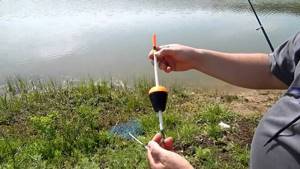
In natural lakes, amateur fishermen use a fishing rod with a transparent or blue float. Often specially prepared long-casting tackle with antennas is used. In the photo you can see how to tie it correctly to catch a silver carp.
Attention! During the daytime, the flock hides in the depths.
For successful fishing, a special bait is used - technoplankton, which, when dissolved, forms a cloud around itself, reminiscent of plankton accumulations. Some fishermen prefer to fish with bottom gear - several hooks are attached to the feeder. The desire to catch prey forces fishermen to use tricks. For bait they use porridge, cookies, bread, halva.
Knowing what the silver carp fish looks like in various photos and having read the description, you can not confuse it with other species. Being unique and having many useful qualities, it will always be a welcome guest on the menu of a culinary establishment of any class.
